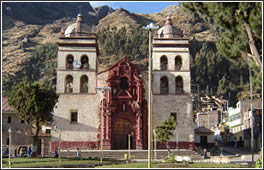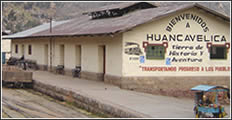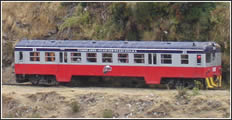Huancavelica Peru – Department, Province and City.
The department of Huancavelica was created on 26th April 1822 by General Don Jose de San Martin. |
|
Huancavelica City is the capital of the department and was founded on 5th August 1572 by Viceroy Don Francisco de Toledo. The original name of the city was Villa Rica de Oropesa, Orepesa being the surname of his parents.
Huancavelica is a comparatively poor area of Peru, despite the fact that there is quite a lot of mining activity. It was a high producer of silver, but production of this has fallen rapidly in recent years. It also has copper, gold, lead and zinc mines.
Right. Photo of the cathedral in Huancavelica. Behind are the mountains where the mercury used to be mined |
 |
More than 60% of the economically active population is employed in agriculture and forestry. Some of the important crops are peas, barley, broad beans, maize, and mashua, all of which represent 10% or more of the total production in Peru of the particular crop.
There is a famous railway line (one of the few in Peru) between Huancavelica and Huancayo, a distance of 128 km over difficult terrain. The original train was called the “Tren Macho” or “Macho Train” as it allegedly “left when it wanted to and arrived when it wanted to or when it was able to.

The station in Huancavelica |
 The small express train that runs between Huancavelica and Huancayo |

The "ordinary train" that hauls freight as well as passenger coaches. This takes around 6 hours compared to the 3-4 hours that the express train takes.
You can read more about the Tren Macho, including departure times, at the following official site for the Department of Huancavelica:
www.regionhuancavelica.gob.pe/DirceturHvca/TrenMacho.htm
Location of Huancavelica and its borders.
Huancavelica is located in the central part of Peru in the middle of the Andes region. To the north it borders with the department of Junin, to the east with Ayacucho, to the south with Ica and Ayacucho, and to the west with Ica and Lima.
Physical geography of Huancavelica
The Cordilleras of Urpicota and Marcavalle cross the department of Huancavelica making this a very mountainous department. There are high mountains and deep valleys.
RIght. "Arial" view of the city of Huancavelica showing something of the mountainous terrain. |
 |
There are several high plains which include the geographical areas known in Peru as Quechua, Suni, Puna or Jalca and Janca or Cordillera.
Valleys include the Huarpa valley and part of the Mantaro valley.
Mountain peaks include Citac (5,329 m.), Huamanrazo (5,303 m), Rosario (5,198 m), Chocca (5,231 m).
Culture in Huancavelica
Archaeology: There are many arquelogical remains. One of the most famous is the ruins of Huaytara in the province of Castrovirreyna. The ruins of Uchcus-Incañan are also well known. This was an important Inca administrative and ceremonial centre near the city of Huancavelica.
Colonial buildings: Huancavelica has many colonial courts and churches.
Right. Photo of one of the colonial churches. |
 |
Literature: Huancavelica has a rich oral tradition – songs, poems and jokes.
Folk dance: The most famous dance from Huancavelica is the "scissors dance" - a rather dangerous dance during which the dancers carry out very acrobatic movements holding one or two pairs of large scissors. (See photo).
Right. Statue of the famous scissors dance. |
 |
Local dishes: “Mondongo”, “puchero, “pachamanca” (meat and potatoes and other things cooked in the ground by the heat of hot stones), zapallo soup.
Famous people connected with Huancavelica
Daniel Hernandez (1856-1932) was a famous classical artist born in the province of Pampas in the Department of Huancavelica. He founded the School of Fine Arts in Lima. He won a silver medal in the Paris exhibition in 1900.
Ernesto Baertl was a famous businessman who formed mining companies in Huancavelica.
Other Facts about the Department of Huancavelica
Population: Around 450,000
Population density: 20 people per km2
Area: 22,131 km2
Important cities: Huancavelica (capital), Acobamba, Castrovirreyna, Churcampa, Pampas. |



 The small express train that runs between Huancavelica and Huancayo
The small express train that runs between Huancavelica and Huancayo



